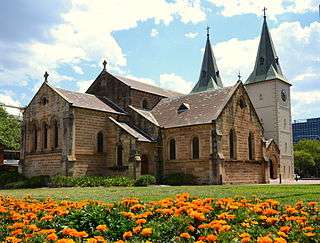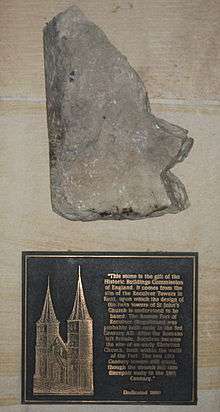St John's Cathedral, Parramatta

St John's Cathedral is a heritage-listed, Anglican cathedral in Parramatta, a city to the west of Sydney, Australia. St John's was given the status of provisional cathedral of the Anglican Diocese of Sydney in 1969, and designated a Regional Cathedral in 2011. It has a federal heritage listing as well as a New South Wales state heritage listing.[1]
History
St John's Cathedral is located near Parramatta railway station and is the oldest church site in Australia in continuous use. In October 1788, soon after the first load of convicts arrived at Sydney Cove, Governor Arthur Phillip took a trip up to find the head of the Sydney Harbour (Port Jackson). Finding inhabitable land there he formed a settlement at Rose Hill (named after Sir George Rose the Under-Secretary of the Treasurer) and mapped out the bare bones of a town that extended from the foot of Rose Hill for one mile eastward along the creek.[2] This place he named Parramatta as this was his interpretation of the name given by the first peoples to the spot on which the town is situated. By the end of 1791 there were one thousand people living in the district and they were ministered by the Rev. Richard Johnstone in a large shed once a fortnight. In a letter to Governor Phillip dated March 23, 1792, Johnstone states: "Last spring there was the foundation of a church laid a Parramatta. before it was finished it was converted into a gaol or lock up house, and now it is converted into a granary. … I go up to Parramatta, as usual, once a fortnight the distance by water about fourteen miles."[3]


On 10 March 1794 the Rev. Samuel Marsden who had been appointed Assistant Chaplain arrived in Parramatta and relieved Johnstone of the care of these Western settlements.[4] On the first Sunday of September 1798 he opened a temporary church which Collins says was: "... formed out of the materials of two old huts. Five years later in October 1799, Governor Hunter is thought to have laid a foundation stone for a new church. This was to be 100 feet long and 44 wide but work proceeded slowly and in 1801 Governor King wrote to Sir Joseph Banks saying; ... nor have we an elegant stone church at Parramatta, one of brick and stone will be finished during the year. But by 1807 Governor Bligh was still complaining that work was still unfinished, although presumably the superstructure was intact as it had been used for worship since 1803."[5]
Made out of brick the predominant feature of the 'Old' St John's Church were the two towers inspired by a similar set on St Mary's Church, Reculver, in Kent.[6] The story behind these somewhat unusual features states that they were made at the request of Elizabeth Macquarie, as St Mary's was the last church she saw as she left England. Governor Macquarie asked his aide-de-camp, Lieutenant John Cliffe Watts of the 46th Regiment, to come up with designs. Frank Walker in his article in the Parramatta Historical Society Journal refers to a drawing folder by Watts in the State Library of New South Wales, Sydney, which includes drawings of the church spires; one of which bears the watermark of 1813 and has Macquarie's initials and approved written on it. Also in the portfolio is an excellent water-colour of St Mary's Church by Watts.[7]
In 1902 the grandson of Marsden, J. S. Hassall, published his book In Old Australia, Records and Reminiscences from 1794, in which he gives a good description of this church. In 1838 Rev Marsden died and was replaced by Rev H. H. Bobart, his son-in-law. Sometime around 1852 it was decided to pull down the old church and erect a new one. The original church was demolished in 1852 and replaced with a new sandstone nave built in Romanesque Revival style to the design of architect-builder, James Houison. All of the main part of the building was removed except for the two towers. In 1883, the transepts were added by E. T. Blacket and Son.[8]
The organ, installed in 1863 at a cost of £359, is one of the most substantial and best-preserved J. W. Walker organs of its period.[9]
Cemetery
The historic St John's Cemetery is located nearby on O'Connell Street.[10] It is the oldest existing European burial ground in Australia. The first interment took place on January 31, 1790, when James Magee, a convict's child, was buried there. The cemetery has a state heritage listing.[11]
References
- ↑ The Heritage of Australia, Macmillan Company, 1981, p.2/50
- ↑ Parramatta Heritage Study, Parramatta Council, 1992
- ↑ Walker, Frank (1918). "St John's Cathedral". Parramatta and District Historical Society, Journal and Proceedings. Volume 1
- ↑ J. S. Hassall,"In Old Australia, Records and Reminiscences from 1794, 1902
- ↑ Walker, Frank (1918). "St John's Cathedral". Parramatta and District Historical Society, Journal and Proceedings. Volume 1
- ↑ Centenary Celebration's, Anglican Church, Australia, 1913
- ↑ Walker, Frank (1918). ",St John's Cathedral". Parramatta and District Historical Society,Journal and Proceedings. Volume 1
- ↑ Walker, Frank (1918). ",St John's Cathedral". Parramatta and District Historical Society,Journal and Proceedings 1.
- ↑ Organ Historical Trust of Australia
- ↑ St Johns Cemetery at Discover Parramatta
- ↑ State Heritage Website
| Wikimedia Commons has media related to St John's Cathedral, Parramatta. |
External links
- St John's Official Website
- St Johns Church Parramatta, Parramatta Heritage and Visitor Information Service blog
- St John's Cemetery Parramatta historical project
Coordinates: 33°48′57″S 151°00′09″E / 33.8159°S 151.0026°E